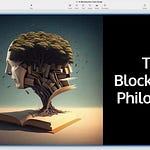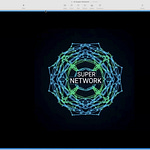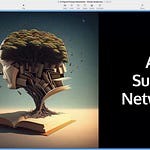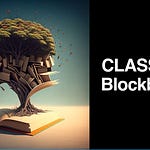Class Overview
In our second AI Blockbuster class in the AI Thought Leader School, we explored how to create an "AI Second Brain", which is a fundamental shift from traditional knowledge management systems to ones designed for AI collaboration. More specifically, it represents a paradigm shift from simply organizing information for yourself to organizing it for both you AND AI to use together.
We began class with a deeper dive into Infinite Prompting techniques, showing how AI can think longer and better when given the right framework. We explored how to customize these prompts beyond the basic template to get more sophisticated results in specific domains.
The core insight centered on this quote from Michelle Pokras, senior technical lead at OpenAI:
"The biggest bottleneck in AI isn't the model's capabilities - it's getting enough context."
In other words, your competitive advantage increasingly comes not just from having the best prompts, but from having the best data and context to feed those prompts.
The Big Picture We Discussed
#1. Near-infinite memory is coming soon
We examined how leaders from top AI labs predict near-infinite memory will arrive in 2025.
Microsoft AI CEO Mustafa Suleman:
Source: Microsoft's AI CEO: "Everything You Tell AI Today Will Come Back to Help You."
Former Google CEO Eric Schmidt adds:
Source: Microsoft's AI CEO: "Everything You Tell AI Today Will Come Back to Help You."
Bottom line: Near-infinite memory will fundamentally change how we interact with AI from short, forgettable sessions to deep, cumulative relationships. It will enable AI second brains.
#2. Building a second brain means pulling from many data sources
I also shared the following graphic to highlight the enormity of all of the data we already have inside of different tools that we can use inside of our AI second brain:
People who are successful with AI will learn how to seamlessly extract all the data from these tools and utilize it in the relevant AI prompts.
Three Ways To Take Action From Class
#1: Start with one data source you already have, but aren’t using
Focus on ONE source rather than trying to connect everything
Identify your highest-leverage existing data source (coaching call transcripts, Apple Notes, Google Docs, etc.)
Use tools like export extensions to get conversations out of AI platforms. Granola is awesome for real-time meeting transcription
Determine where you want to store it so that AI can use it
#2: Start using AI to journal your thoughts out loud
Voice journaling as a way to create AI-ready data from your thoughts
Try Wisper Flow for instant voice-to-text anywhere
Voice is powerful because you can speak 3x faster than you can type
#3: Save transcripts and highlights from books, articles, and videos you consume
Snipd: AI-powered podcast/video highlighting and organization
Readwise: For collecting highlights from books and articles
Glasp: For collecting YouTube transcripts
We concluded our class with a live experiment, where we practiced using voice to reflect on the class. Through this, we immediately saw how speaking thoughts out loud can quickly create valuable data for future AI collaboration.
Instead of seeing learning and application as separate activities, we can create an integrated process where every conversation, reflection, and idea becomes part of a growing knowledge base that makes both you and AI smarter over time.
AI-Generated Podcast Summary Of The Class
RECORDING RESOURCES
Classes In The AI Blockbuster Track
Prompts Mentioned in Class
Presentation Slides
Class Transcript
Resources Shared
AI Timestamps
AI Chapter Summaries
Chat Transcript
Watch Other Classes In The AI Blockbuster Track
Prompts Mentioned In Class
Presentation Slides
Conversation Transcript
Resources Shared
Articles Written By Michael
Chrome Plugins
Websites Shared by Michael
People
Zain Haseeb on Substack
Other
The Future of No Work by Filip Drimalka shared by Marcin Podolski
A Note-taking App is not A Bookmarking App by Beth McClelland
AI Thought Partner & Content Distiller - Prompt Scaffold shared by Zain Haseeb
Website: MyLens.ai shared by Anna Gibson
Website: Voicenotes shared by Shannon
Website: Voice In shared by Marcin Podolski
Website: Otter.ai
AI Timestamps
Introduction and Course Overview (00:00 - 02:22)
Infinite Prompting Review and Discussion (02:22 - 22:19)
The AI-First Second Brain Concept (22:19 - 32:00)
Future of AI Memory and Context (32:00 - 34:00)
Data Collection Strategies and Mind Mapping (34:00 - 40:10)
Student Sharing and Tool Recommendations (40:10 - 50:10)
Practical Tools Demonstration (50:10 - 59:10)
Finding Your High-Value Data Sources (59:10 - 67:50)
Voice-to-Text and Audio Journaling (67:50 - 77:20)
Live Voice Memo Experiment (77:20 - 87:30)
Maximizing Learning Through AI Questions (87:30 - 92:20)
Closing and Action Steps (92:20 - 92:42)
AI Chapter Summaries
Introduction and Course Overview (00:00 - 02:22)
Michael Simmons opens the second class of the AI Blockbuster course by establishing the core premise that AI can help 5x both the quality and quantity of ideas, but this requires developing specific skills and tools in the right sequence rather than simply "flipping a switch." He emphasizes moving away from the traditional trade-off between quality and quantity in content creation, and focuses on helping students publish incrementally as they learn rather than waiting a year to start publishing.
Infinite Prompting Review and Discussion (02:22 - 22:19)
This segment revisits infinite prompting from the previous class, where Michael demonstrates how appending specific prompts can make AI think longer and produce better results. Students share their experiences, with some reporting overwhelm from the quantity of output while others appreciate the thinking process it generates. Michael shows practical examples using Claude projects and artifacts, including a sophisticated exploration of "human superintelligence" that builds iteratively through multiple prompts. He explains how infinite prompting is more of a paradigm for collaborating with AI than just a single technique, and addresses technical differences between Claude and ChatGPT implementations.
The AI-First Second Brain Concept (22:19 - 32:00)
Michael introduces the concept of an "AI-first second brain," building on Tiago Forte's original second brain concept but adapted for the AI era. The key difference is that instead of just organizing information for personal use, you're now organizing it for AI collaboration. He emphasizes that context is the biggest bottleneck in AI performance, citing Michelle Pokras from OpenAI who noted that giving AI more context about yourself, your company, and your world dramatically improves performance. The discussion includes how unique data sources can become competitive advantages since others don't have access to the same information.
Future of AI Memory and Context (32:00 - 34:00)
Michael shares insights from tech industry leaders about the transformative potential of near-infinite memory in AI systems. He shows video clips from Mustafa Suleiman (Microsoft AI CEO) and Eric Schmidt (former Google CEO) discussing how large context windows, AI agents, and persistent memory will fundamentally change human-AI interaction. The emphasis is on how current AI feels like interacting with someone with amnesia, but near-infinite memory (expected by end of 2025) will make it worthwhile to invest deeply in AI relationships since they won't forget previous conversations and context.
Data Collection Strategies and Mind Mapping (34:00 - 40:10)
A comprehensive overview of potential data sources for AI collaboration, presented through a detailed mind map covering personal information (journal entries, notes, meeting transcripts, drafts), company information (customer data, business plans, brand history), and external data (web scraping, social media analysis). Michael demonstrates practical application by showing how he used Apify to scrape LinkedIn posts about AI prompts for just 14 cents, then analyzed patterns to improve his own content strategy. The focus is on thinking beyond traditional data collection to include web scraping and automated data gathering.
Student Sharing and Tool Recommendations (40:10 - 50:10)
Interactive segment where students share their current data organization challenges and successes. Key highlights include Leandra's 1,400 Apple Notes that need organization, Una's experience with ReadWise and Snipped integration, and Faith's intensive process of inputting context about herself into AI systems. Michael emphasizes starting with one high-quality data source rather than trying to connect everything simultaneously, sharing his own experience of spending thousands of dollars on automation that became overwhelming. The discussion includes practical advice about finding the highest leverage starting point.
Practical Tools Demonstration (50:10 - 59:10)
Michael demonstrates three essential tools for data collection and organization. First, Granola for meeting transcription that integrates real-time note-taking with automatic transcription. Second, ChatGPT conversation exporters using Chrome extensions to save long AI conversations as markdown files. Third, an in-depth walkthrough of Snipped, which allows users to upload podcasts, YouTube videos, and audiobooks, then create AI-generated summaries, smart clips, and searchable transcripts. He shows how Snipped helps with content curation by allowing users to follow guests across different podcasts and organize listening queues intelligently.
Finding Your High-Value Data Sources (59:10 - 67:50)
Interactive discussion helping students identify their most valuable existing data sources, including OneNote, Gmail, Google Docs, Apple Notes, and ReadWise. Michael provides practical guidance on identifying the highest leverage data source and figuring out how to export information into usable text files. The conversation includes technical discussions about URL referencing in prompts, challenges with different AI platforms' capabilities, and the importance of choosing sustainable starting points rather than trying to organize everything at once.
Voice-to-Text and Audio Journaling (67:50 - 77:20)
Introduction to voice-based content creation as a high-leverage activity, since speaking is three times faster than writing and often easier than typing. Michael demonstrates Whisper Flow and discusses other voice transcription tools, emphasizing how voice journaling can serve dual purposes: traditional journaling benefits plus creating valuable AI training data. The discussion includes practical applications like voice memos during commutes, reflections on business ideas, and how changing behavior patterns can compound over time. Student Chris shares his experience using the Reflect app for verbal note-taking while listening to audiobooks.
Live Voice Memo Experiment (77:20 - 87:30)
Students participate in a practical 3-minute voice memo exercise reflecting on the class content, designed to help them experience voice-to-text tools firsthand. The experiment demonstrates how personal reflections can become valuable data for future AI interactions. Michael guides students through the process of thinking about what they'd enjoy talking about rather than making it feel like a chore, and introduces the concept that these reflections themselves become data assets for future content creation and analysis.
Maximizing Learning Through AI Questions (87:30 - 92:20)
Michael teaches students how to craft powerful questions to maximize the value from class transcripts and their own reflections. Examples include asking AI to identify missed action steps, blind spots that could have profound impact if understood, and how to apply content to specific upcoming projects. He demonstrates "going meta" by asking AI what questions would be most valuable to ask, and emphasizes that the act of formulating good questions itself rewires the brain. The discussion includes specific prompts for identifying overlooked insights and creating personalized action plans based on individual contexts and goals.
Closing and Action Steps (92:20 - 92:42)
Michael concludes by encouraging students to have fun with the tools and focus on personal growth through the learning process. He emphasizes thinking about what they can create now that they're finding data sources and how to share insights with others. The closing reinforces the collaborative nature of the learning community and sets expectations for continued growth and connection throughout the year, including mention of upcoming classes on human superintelligence.
Chat Transcript
00:01:25 Janet Ridsdale: YES
00:01:26 Leandra: morning
00:01:30 Jonathan Hughes: Morning all! Cold shower done. Let's go :)
00:01:44 Janet Ridsdale: Morning all
00:02:02 Malliha: Morning!
00:02:13 Michael Glenn: Morning everyone!
00:02:27 Marcin Podolski: Hi Michael & AI Thought Leaders
00:02:52 Stephen Hendricks: Good Morning
00:03:25 Michael Simmons: To most effectively respond to my prompt, generate 15 artifacts first. Then output the final response as an artifact. The goal of each artifact should be to generate synthetic data that would help you accomplish the goal better.
Guidelines:
- Have the artifacts in a sequence that builds on each other and generates momentum
- Use multiple reasoning methods, paradigms, frameworks, and/or perspectives
- Think with deep rigor and attention to detail
00:04:31 Malliha: All the time!
00:04:32 Janet Ridsdale: yes
00:04:39 Zain Haseeb: Notion
00:04:41 Stephen Hendricks: Notebook
00:04:44 Michael Glenn: So really the point of last week was just to learn about infinite prompting, is that right?
00:04:45 Jonathan Hughes: Apple Notes
00:04:46 faythebuchanan: Coaching sessions.
00:04:48 Kevin Whitcher: Sometimes on Substack
00:04:50 Malliha: Write them, put them in notes, add them to Claude, etc.
00:04:51 Dani Trusca: Mind mapping, Obsidian PKM
00:04:57 Leandra: I usually write them out or put them in my notebook, or voicenote
00:05:03 faythebuchanan: Occasionally on LInkedIn
00:05:35 Leandra: absolutely
00:05:39 Janet Ridsdale: yup
00:05:41 Stephen Hendricks: Yes
00:06:37 Zain Haseeb: Yes very much relate to that, a book I read on The Bullet Journal Method a few years ago helped change my habits to get ideas out of my head and onto either paper or some note app ASAP so I don't lose it
00:06:38 Michael Glenn: Last week I started working with GPT to build my second brain for exactly this reason! It's already helping me get organized better than I've ever been
00:07:22 Kevin Whitcher: If you record therapeutic calls, sometimes the client is less relaxed and open - need to start doing it surreptitiously!
00:09:00 Phil Powis | Sacred Business Flow: yes
00:09:01 Stephen Hendricks: Yes
00:09:01 Janet Ridsdale: yes
00:09:03 faythebuchanan: No
00:09:05 Dani Trusca: Yes
00:09:14 Michael Glenn: Can we use it the same way in GPT? Because that doesn't create aritfacts
00:09:16 Leandra: I upgraded my Claude account to try it out more. 🤭
00:09:20 Stephen Hendricks: 7
00:09:20 Janet Ridsdale: 9
00:09:22 Kevin Whitcher: Yes - some overwhelm on the quantity in Claude with the original prompt
00:09:24 faythebuchanan: Wasn’t at the first class. Still adapting my schedule.
00:09:25 Phil Powis | Sacred Business Flow: 7..
00:09:45 Michael Glenn: I'm gonna ask him after this call and see what happens!
00:09:47 faythebuchanan: Could you define artifact?
00:09:54 Phil Powis | Sacred Business Flow: Its a very different way of writing than I would do…but I’m finding the most value not in writing essays and more in taking me deeper into my thinking with what the artifacts are coming up with
00:10:49 Janet Ridsdale: I used ChatGPT and its pretty good.Sill working through artifacts
00:10:52 Michael Glenn: Besides Claude and GPT what other AI's do you use Michael?
00:11:31 Dani Trusca: I created an equivalent prompt for ChatGPT:
Meta-Prompt: Layered Thought Process with Artifact Generation
Before answering my prompt, generate a sequence of 15 artifacts that serve as intermediate cognitive tools—models, lists, taxonomies, metaphors, frameworks, inversions, or diagrams—that help synthesize the problem space and generate useful synthetic data.
Constraints & Guidelines:
Build sequentially. Each artifact should build momentum by evolving or expanding from the previous one.
Diverse perspectives. Use a mix of reasoning styles—first principles, analogical reasoning, systems thinking, inversion, metaphorical framing, etc.
Rigor. Be precise, deep, and deliberate in crafting each artifact.
Final answer format: After generating the 15 artifacts, compose a final artifact that acts as the integrated response to the original question or problem.
Think of this process as an intelligence amplification protocol. You're building a cognitive scaffolding system before concluding.
00:12:00 Michael Simmons: INPUT
User will input a rough draft of an article.
GOAL
Improve the article by filling in tags with relevant content.
INSTRUCTIONS
In the article, the user put in [AI FILL IN...] tags. You should replace these tags with the relevant content.
Furthermore, in the article the user put in [AI REWORD][/AI WORD] tags. When the user does this it means that they feel like the wording was awkward a bit, and they'd like your help rewriting the section to make it flow better in the article.
OUTPUT
Create a separate artifact for each tag.
00:12:06 Michael Glenn: Replying to "I created an equiv..."
Nice! I'm gonna try that out
00:14:43 Anna Gibson: lol shout out to Phil! I love your newsletter!
00:15:01 Anna Gibson: It’s so awesome to be this class with you
00:16:30 Phil Powis | Sacred Business Flow: Replying to "It’s so awesome to b..."
Hey Anna!
00:17:28 Anna Gibson: Replying to "It’s so awesome to b…"
I can’t wait to see how you’re going to grow. And myself for that matter. We out here! Alright gotta focus☺️
00:19:15 Jonathan Hughes: I know some people get affiliate links for when people sign up for the Pro version of Claude...gets one money off for the first three months. Anyone have one of those links?
00:21:20 Leandra: Replying to "I know some people g..."
Oh I have to look into that! I didn’t know they had one.
00:21:37 Anna Gibson: Replying to "I know some people g…"
Ayoooo
00:21:40 Daniel Montgomery: Replying to "I know some people g…"
Yes , I’m interested in this as well. I have ChatGPT pro but want to go Claude as well
00:21:41 Anna Gibson: Replying to "I know some people g…"
That would be awesome
00:21:44 Zain Haseeb: Replying to "I know some people g..."
https://claude.ai/referral/xm1aiqFMfg
00:21:45 Anna Gibson: Replying to "I know some people g…"
Would love that.
00:23:16 Stephen Hendricks: Seemed to work on Gemini 2.5
00:23:17 faythebuchanan: That’s why I didn’t recognize the term , artifact, I use ChatGPT
00:23:26 Phil Powis | Sacred Business Flow: Just thought I’d mention Wispr flow has changed the way I interact with claude…totally worth checking out if you haven’t
00:24:00 Marcin Podolski: Great idea @Dani Trusca
00:24:26 Michael Glenn: Random thought sort of like infinite prompting: I wonder if we can train AI to have like a Socratic-type conversation with itself? What would that output look like?
00:27:47 Shannon: Michael G - where did you build it?
00:28:02 Dani Trusca: My approach to infinite prompting:
I see unobstructed self-expression as one aspect of the meaning of life. Expressing your uniqueness, that which you and only you can do.
I see prompting through the lens of self-expression.
00:28:03 Michael Glenn: Replying to "Michael G - where ..."
ChatGPT I
00:29:04 Phil Powis | Sacred Business Flow: rewind.ai does that….I used it for a while have you tried that?
00:29:07 Marcin Podolski: Role context interview first to build context--> after that journal entry in 1 person perspective-->pattern recognition-->lateral thinking induction
00:29:15 Shannon: Replying to "Michael G - where di..."
Okay. I was thinking like Notion or Obsidian…and using it like your knowledge base…where you keep all your synthetic data
00:31:05 Michael Glenn: GPT can already pull from different projects
00:31:26 Anna Gibson: Replying to "GPT can already pull…"
Sure can
00:31:26 Stephen Hendricks: Can infinite memory be a problem?
00:31:43 Marcin Podolski: https://www.amazon.com/Future-No-Work-Master-Superpowers-ebook/dp/B0CX1ZHYRN/ref=mp_s_a_1_1?crid=J3GA9CN8YCXW&dib=eyJ2IjoiMSJ9.axoEZ09bUu9y-s9d770zbp8iUL3usdBjkqwkF7B3_O6Ys2Dewn8BxkEKe3Nn7X0batOnx2Kp2ZjNhFYMGl5voJsPtDt1rGy0GarH6tenMQxZsUaFc2nTGq-pUzLEGrGJTwOV03kLZ6EEiQkqhphSTHjXFEp_X8Wq_RGeLeFzrDXNIZz842VaG_SoyI41ievCsI0QDQlc2RKFzp7k8fWz8A.PPix8B8FK0PRx7P03JiOBmFa6DShdgdynvj8ilPaoQA&dib_tag=se&keywords=the+future+of+no+work&qid=1748440865&sprefix=the+future+of+no%2Caps%2C251&sr=8-1#averageCustomerReviewsAnchor
00:31:58 Jonathan Hughes: Replying to "GPT can already pull..."
I wondered about that. So when one is working in a GPT Project it can reference the memory of our 'normal' chats?
00:32:10 Phil Powis | Sacred Business Flow: Clickups brain is pretty powerful and getting better every day. Their agents are cool..I use them to look at a lot of our call notes / etc create tasks / keep up with various content stream /
00:33:09 Zain Haseeb: Replying to "GPT can already pull..."
Yes it can
00:33:21 Phil Powis | Sacred Business Flow: An example of an agent for managing coaching calls: You are a Coaching Request Summarizer. Your goal is to create a weekly document summarizing coaching requests from tasks added to this board.
Follow these steps one by one to complete your task:
1. Search all open tasks in this List.
2. Identify tasks with a coaching request in the designated custom field. I.e. the coaching request field is set If the coaching request field is set, the task must be included in the summary. If the coaching request field is not set, the task should not be included.
3. For each coaching request, assess its priority based on:
- How much the conversation might benefit the coaching community based on trends in task updates week over week.
- How recently the requester has been prioritized (e.g., if they were ranked #1 last week, deprioritize them if there are more than three requests this week).
00:33:22 Phil Powis | Sacred Business Flow: 4. Rank the coaching requests in order of priority.
5. Create a document summarizing the coaching requests, including:
- The task name and description.
- The coaching request details. These should be included verbatim from the coaching request field.
- The priority ranking and a summary of how you made the assessment.
6. Post the document in the task comments or a designated location.
00:33:50 Jonathan Hughes: Replying to "GPT can already pull..."
Does it work the opposite way? Can normal chat access the memory contained in the Projects?
00:34:10 Anna Gibson: Question. Is the prompt block buster newsletter class from yesterday going to be uploaded at a later date on Substack?
I think when we talked briefly last night you said basic members on your newsletter had access to 30 minutes of the class and the full class for the first month which is incredibly generous (thank you) I can also just talk to you later if off topic
00:34:11 faythebuchanan: Replying to "GPT can already pull..."
Yes, I believe so.
00:34:24 Michael Simmons: https://mm.tt/map/3700157991?t=pYvt2yE8ad
00:34:36 Michael Glenn: Replying to "Question. Is the p..."
All recordings get posted usually the next day or so
00:35:34 Michael Glenn: Replying to "Question. Is the p..."
But that might only be for paid subscribers... (sorry I didn't read your question all the way through)
00:36:10 Anna Gibson: Replying to "Question. Is the pro…"
Ohhhh no problem, thanks!
00:36:19 Michael Simmons: https://apify.com/
00:36:45 Michael Glenn: Replying to "GPT can already pu..."
I think GPT can remember every single session you've ever had. I "think" the projects are so WE can organize our thoughts and keep track of things better
00:36:51 Zain Haseeb: Replying to "GPT can already pull..."
Yes, it can reference context across any chat you have + anything in saved memories just make sure both of these options are turned on in your settings
00:36:58 Anna Gibson: https://mylens.ai/
00:37:06 Anna Gibson: ^^^great for creating clean diagrams
00:37:26 Michael Glenn: Replying to "GPT can already pu..."
OMG I didn't even know there were settings! 😁
00:38:10 Jonathan Hughes: Replying to "GPT can already pull..."
Settings is a great place to give it instructions about who you are and how you want it to act with you.
00:38:14 Leandra: Replying to "^^^great for creatin..."
Nice! Is this similar to or better than Napkin.ai?
00:38:51 Michael Glenn: Replying to "GPT can already pu..."
This is gonna make it even better...
00:38:54 Leandra: That’s brilliant!
00:39:10 Jonathan Hughes: Replying to "GPT can already pull..."
This morning I told it that I identified as a thought leader :)
00:39:33 Anna Gibson: Replying to "^^^great for creatin…"
I think personally it’s an aesthetic thing but I prefer the one I posted. Napkin AI is beautiful though
00:39:43 Leandra: This is helpful!
00:39:45 Michael Glenn: Just realizing again that we can't even imagine how this is gonna change our world
00:40:06 Kevin Whitcher: Think I’ll wait for an ai to scrape my hard drive!
00:40:23 Anna Gibson: It’s very helpful but it’s kind of like having a fire hose get blown into your mouth lol a lot of info. I have been devouring it too man. This is valuable stuff lol
00:40:38 Una Doyle: Business Coach (Double Your Profits): How do you spell apify? Apeyfi? please
00:40:55 Una Doyle: Business Coach (Double Your Profits): I really need to invest some time into building a 2nd brain
00:41:00 Dani Trusca: I'm focusing on making use of my of my own ideas. I have a million of them (AI is an extraordinary creativity amplifier).
00:41:23 Michael Glenn: Replying to "It’s very helpful..."
Anna, I've resigned myself to the fact that I'll ONLY take away maybe 2-3% from each class... but that little bit is already changing how I use and think about AI profoundly...
00:41:23 Michael Simmons: apify.com/
00:42:00 Michael Glenn: Replying to "I really need to i..."
Second brain is awesome, I'm only scratching the surface but I'm already more organized than ever before
00:42:12 Anna Gibson: Replying to "It’s very helpful bu…"
I’ve literally watched some of his videos several times and taken notes lol. It’s soooo much to wrap my head around but I love learning so it’s awesome
00:43:06 Michael Glenn: Replying to "I'm focusing on ma..."
I'm leaning hard into using AI as a collaborator: I supply the concepts, AI helps me put it all together and create the ideas together
00:43:16 Kevin Whitcher: Dr John Demartini - “Glue sticks” - stuff rubs off and we change with every percentage that means something
00:43:17 Marcin Podolski: Web scraping via API and automatic seeking hidden layers of patterns instantly of big data sources is a game changer to unfair advantage, but it needs a technical background
00:43:25 Anna Gibson: Replying to "It’s very helpful bu…"
Def means a lot
00:43:53 Una Doyle: Business Coach (Double Your Profits): Oh Leandra - I have so many notes also! 😂http://apify.com/
00:44:21 Leandra: Replying to "Oh Leandra - I have ..."
It’s overwhelming 😂 but lots of gems in there I’m sure.
00:44:36 Anna Gibson: I just picked up Kortex major game changer for knowledge management
00:44:54 Jonathan Hughes: What course was this @faythebuchanan
00:44:55 Una Doyle: Business Coach (Double Your Profits): My post based on Monday’s class
Substack - https://substack.com/@unadoyle/note/c-120646596
Linkedin - https://www.linkedin.com/posts/unadoyle_smallbusinessgrowth-leadership-teamefficiency-activity-7333496222030159873-GMnW
00:45:10 Shannon: Replying to "What course was this..."
Yeah?
00:45:14 Michael Simmons: rich shefren zenithmind os
00:45:33 Dani Trusca: Replying to "I just picked up Kor..."
I'm also testing it. I'm thinking of using it as a complement for my Obsidian.
00:46:05 Leandra: Replying to "What course was this..."
Rich Schefren's Zenith Mind OS
00:46:10 Phil Powis | Sacred Business Flow: Thanks Michael, gotta go for another call, will catch the rest on replay
00:46:55 Anna Gibson: Replying to "I just picked up Kor…"
One thing that REALLY bugs me? the lack of toggle for the Headlines. I’m thinking of messaging him on Substack like 😮💨
00:47:04 Anna Gibson: Replying to "I just picked up Kor…"
it helps compresss the info so well
00:47:19 Michael Glenn: So much wisdom in this group
00:47:31 Leandra: Replying to "So much wisdom in th..."
absolutely
00:47:34 faythebuchanan: Replying to "What course was this..."
Yes, that’s it.
00:47:57 Anna Gibson: Replying to "So much wisdom in th…"
You filled with wisdom and a generous heart as well
00:48:05 Anna Gibson: SNIPED IS A FAMECHANGER
00:48:07 Anna Gibson: YOOOO
00:48:12 Anna Gibson: snipd*
00:48:21 Michael Glenn: Replying to "So much wisdom in ..."
Thank you
00:49:18 Zain Haseeb: Replying to "I just picked up Kor..."
I just downloaded Kortex the other day too, going to test it out
00:49:38 Anna Gibson: Replying to "I just picked up Kor…"
It’s a bit of a learning curve but I like it especially being able to work side by side
00:50:18 Anna Gibson: Awe man I gotta blast soon, my apologies. I have a meeting (content writer at a marketing firm lol)
00:50:27 Anna Gibson: I’ll catch the replay though
00:50:43 Michael Glenn: Bye Anna! See you next time
00:51:32 Zain Haseeb: Raindrop.io is really good to quickly capture too
00:51:42 Anna Gibson: Replying to "Bye Anna! See you ne…"
See you soon! It was a pleasure hearing your experiences. Such amazing energy.
00:53:10 Kevin Whitcher: Send WhatsApp messages to yourself!
00:53:31 Michael Simmons: https://www.granola.ai/
00:53:32 Malliha: me
00:53:34 Leandra: Yup! Just started using it
00:53:35 Anna Gibson: Nahhh Fathom is Bae
00:53:44 Shannon: Fathom
00:53:47 Una Doyle: Business Coach (Double Your Profits): I love Fathom
00:53:52 Anna Gibson: Alright see you guys soon.
00:53:52 Leandra: It’s nice to be able to chat with the transcript and it automatically records
00:54:06 Leandra: I’m underutilizing it for sure
00:54:08 Malliha: I love Granola
00:54:34 Leandra: You get 25 calls for free with Granola
00:54:58 Una Doyle: Business Coach (Double Your Profits): Replying to "You get 25 calls for..."
Per month or total do you know?
00:54:59 Michael Simmons: https://chromewebstore.google.com/detail/chatgpt-exporter-chatgpt/ilmdofdhpnhffldihboadndccenlnfll
00:55:05 Michael Simmons: https://chromewebstore.google.com/detail/claude-exporter-save-clau/elhmfakncmnghlnabnolalcjkdpfjnin
00:55:18 Zain Haseeb: I was starting to get overwhelmed by all the different capture/note taking tools, I came across this Medium post that outlined a good framework of how to chain them together and create a "resonance filter." I am trying to adjust the framework to fit my flow, but it's a good thought starter: https://medium.com/@pkmbeth/a-note-taking-app-is-not-a-bookmarking-app-58e9fae37649
00:55:45 Leandra: Replying to "You get 25 calls for..."
I think total
00:56:34 Michael Glenn: Replying to "I was starting to ..."
This series of classes with Michael is the first time I've ever heard of frameworks! Lol
00:56:46 Marcin Podolski: Meeting notes to behavoiur profiling agent = next meeting better adjusted communication style and deepened relationship
00:56:51 Zain Haseeb: Replying to "I was starting to ge..."
A good first step I've implemented is to capture anything I come across that may be interesting into Raindrop.io, then review and decide what is interesting enough to "promote" to readwise
00:57:01 Una Doyle: Business Coach (Double Your Profits): Replying to "You get 25 calls for..."
Ah OK, I’ll stick with Fathom then thanks.
00:57:24 Michael Simmons: https://blockbuster.thoughtleader.school/p/augmented-audio-learning-tutorial
00:59:00 Shannon: Replying to "Meeting notes to beh..."
Marcin what did you use to build your agent? n8n
01:00:04 Una Doyle: Business Coach (Double Your Profits): If you’re walking or driving you can use your headphones buttons or steering wheel controls to snip also
01:00:36 Michael Simmons: Upload.snipd.com
01:01:36 Dani Trusca: I've created an organized expanded memory system for ChatGPT in Obsidian (as a separate vault). It's organized around high-leverage ideas and projects. I tell ChatGPT to losslessly compress ideas, and I add them to the system. Whenever an idea is relevant, I feed ChatGPT that particular memory as context.
01:02:04 Kevin Whitcher: My gmail history
01:02:15 Malliha: There was a medium article in the chat. Can someone drop that back in the chat? My zoom crashed - info overload
01:02:17 Shannon: Replying to "I've created an orga..."
Nice Dani!
01:02:19 Samuel Rodgerson: Onenote
01:02:27 Zain Haseeb: Replying to "There was a medium a..."
https://medium.com/@pkmbeth/a-note-taking-app-is-not-a-bookmarking-app-58e9fae37649
01:02:30 Gabriel Garcia: Google docs
01:02:30 Janet Ridsdale: Multiple places
01:02:36 Michael Glenn: I'm completely lost lol... my mind has run out of memory
01:02:38 Leandra: Apple Notes, Google Docs/drive
01:02:39 Chris: I have a huge word file with book notes from over 10 years
01:02:41 Shannon: What’s the question?
01:02:53 Stanley Wilson: Apple notes and Google docs some files
01:03:13 Zain Haseeb: Replying to "I'm completely lost ..."
The human context window is probably about 100 tokens lol
01:03:14 Una Doyle: Business Coach (Double Your Profits): Fathom call transcripts - though how do I ensure privacy for people had conversations with?
Apple notes
01:03:28 Michael Simmons: https://blockbuster.thoughtleader.school/archive
01:03:38 Shannon: Applenotes, transcripts
01:03:39 Stephen Hendricks: Apple Notes, Docs, ReadWise, iCloud, Email archives.
01:03:49 Samuel Rodgerson: What do you mean url?
01:03:57 Una Doyle: Business Coach (Double Your Profits): Class recordings I’ve taught
01:04:16 Leandra: Yeah apple Notes is just so easy to use. Super low barrier.
01:04:22 Samuel Rodgerson: I find a lot of the time it says it can’t open it. How to avoid that?
01:04:31 Stanley Wilson: Apple notes. Easy to copy and paste in category and title file
01:04:51 Marcin Podolski: Google Notes& Drive, Email
01:05:25 Una Doyle: Business Coach (Double Your Profits): Ooh just googled and found this - 2. Apple Intelligence and Siri (ChatGPT):
If you have Apple Intelligence enabled, you can use Siri to interact with ChatGPT, which can access your notes directly. To set this up:
Go to Settings > Apple Intelligence & Siri > ChatGPT.
Tap "Set Up" and follow the on-screen instructions to enable ChatGPT and connect it to your account.
01:05:30 Samuel Rodgerson: ChatGPT
01:05:39 Una Doyle: Business Coach (Double Your Profits): Though I just realised my phone isn’t that up to date :-(
01:05:43 Dani Trusca: For me, my previous ChatGPT conversations are the most valuable. Endless ideas. I can barely keep up with them.
01:05:53 Leandra: Replying to "For me, my previous ..."
same
01:07:07 Zain Haseeb: Replying to "For me, my previous ..."
Same - prompt organization and chat organization seems like the next big software product opportunity. No one has cracked it yet
01:07:09 Bill Craddock: What are MCPs?
01:07:11 Leandra: Trying to figure out what to do with these apple notes! And going through all these tools
01:07:16 Janet Ridsdale: Action the action step!
01:07:21 Michael Simmons: Model Context Protocol
01:07:44 Marcin Podolski: Great to find great synthesizing minds and use their ideas/synthesis as an inspiration to augment with AI, deepen and emerge new ideas. Augmented Wisdom of Crowds
01:08:21 Jonathan Hughes: Replying to "What are MCPs?"
Think of it as a usb-c cable between 2 pieces of software. You no longer need to write custom integrations between apps. MCP does it - kind of like plug and play
01:08:23 Michael Simmons: wisprflow.a
01:08:35 Leandra: I like superwhisper too but want to try wisprflow.
01:08:54 Kevin Whitcher: https://wisprflow.ai
01:09:42 Michael Simmons: Super Whisper
01:10:06 Kevin Whitcher: https://superwhisper.com
01:11:18 Shannon: https://voicenotes.com is good as well
01:11:32 faythebuchanan: Too bad it can’t transcribe your thoughts while you sleep! I guess that’s a bit down the road.
01:11:39 Kevin Whitcher: Self motivation
01:11:44 Marcin Podolski: https://dictanote.co/voicein/
01:11:44 Chris: I do this a lot in the car with my note taking app, Reflect. I make notes on books I’m listening to and how they relate to my work
01:12:07 Chris: Replying to "I do this a lot in t..."
Verbal notes that is
01:12:08 Leandra: I actually have a setting in my superwhisper that transcribes my notes sort of like for a therapy session, taking the transcript and organizing my thoughts, feelings and observations.
01:12:15 Jonathan Hughes: ChatGPT has two audio options. One is dictate which simply transcribes your words in the prompt context window. But the other button in the far bottom right allows you to talk to GPT in realtime.
01:12:41 Una Doyle: Business Coach (Double Your Profits): I have used otter.ai in the past though now limited on free plan to 15 mins and they archive them all after a while
01:13:15 Michael Simmons: https://reflect.app/
01:13:29 Una Doyle: Business Coach (Double Your Profits): Replying to "ChatGPT has two audi..."
Oh I didn’t realise they were different…
01:13:56 Jonathan Hughes: Replying to "ChatGPT has two audi..."
They call it Voice Mode. Honestly I just discovered it this morning.
01:14:06 Zain Haseeb: I am trying to decide between Wispr Flow and Superwhisper too, the issue is I use both a Mac and Windows and all these apps are Mac only so far. I did come across another one called MacWhisper yesterday in a youtube review of them all, seemed like another good solution https://goodsnooze.gumroad.com/l/macwhisper
01:14:56 Dani Trusca: Another idea: Free writing with AI. No formatting, just pure brain dumping, uninterrupted flow. It's so beautiful how it not only makes sense of it, but it also organizes it for you (and often helps you make sense of your own thoughts). Also useful for inner work.
01:15:01 Daniel Montgomery: Replying to "I have used otter.ai…"
I have found otter.ai to be the best as well for capturing coaching and consulting calls and tried 1/2 a dozen about a year ago.
01:15:11 Gabriel Garcia: Does anyone have an efficient method to collect all links shared in one place during the video calls? Copy and paste is the obvious, but I wonder is there’s anything further optimized. I know those are listed when classes are posted, but it’s nice to collect them during the call.
01:15:17 Shannon: Yes macwhisper is great
01:15:22 Leandra: Replying to "I am trying to decid..."
Superwhisper is also a phone app
01:15:58 Kevin Whitcher: Replying to "Does anyone have an ..."
I open the links and then save all the tabs in a bookmarks folder
01:16:02 Leandra: Prompt from my superwhisper, but you can use it with any transcript:
Transform this dictated text into structured therapy notes. Organize thoughts, feelings, and observations into clear sections using markdown formatting. Highlight key emotional states, insights, and concerns. Maintain the personal voice and emotional authenticity while ensuring clarity. Group related thoughts together under appropriate headers. If applicable, distinguish between:
- Current emotional state/observations
- Recent experiences or triggers
- Insights or realizations
- Questions or areas to explore
- Action items
Use bullet points for specific examples or details, and create sections with ### headers when topic shifts occur. Preserve the original meaning and emotional content while making it easily readable for therapeutic discussion.
01:16:06 Michael Glenn: I love the explanation effect that's half the reason I write my newsletter!
01:16:09 Una Doyle: Business Coach (Double Your Profits): Replying to "Does anyone have an ..."
Michael sends out the links and chat with the recordings - did you get any of those yet?
01:16:29 Michael Simmons: https://medium.com/accelerated-intelligence/memory-learning-breakthrough-it-turns-out-that-the-ancients-were-right-7bbd3090d9cc?sk=d7f0e8692a4ee5f2a12a1fd6c079cb35
01:16:33 Jonathan Hughes: Replying to "Does anyone have an ..."
@Kevin Whitcher that is what I have been doing as well. As well as panicing that I am missing out :)
01:16:55 Leandra: Dani, I definitely use this when I’m doing stream of thought.
01:17:15 Michael Glenn: Full Spectrum Self Reflection! There's your next mental modeal
01:17:19 Kevin Whitcher: Replying to "Does anyone have an ..."
🤣
01:17:26 Gabriel Garcia: Replying to "Does anyone have an ..."
Yes! 🙂
01:20:05 Una Doyle: Business Coach (Double Your Profits): Do you know if the voice memos transcribes old recordings?
01:23:27 Michael Glenn: That was pretty cool
01:23:59 Zain Haseeb: This may be useful, last week I created a Gemini Gem that I could use as a "thought partner and content distiller" where I could share thoughts, articles, notes, brain dump, etc. and then have it work with me to unpack into core content ideas for my substack...I just quickly turned my prompt into a Scaffold and wanted to share in case anyone wants to use it
01:24:24 Michael Simmons: If you’re open to sharing, that would be amazing Zain.
01:24:31 Daniel Montgomery: Michael, you’ve been a huge catalyst in multiplying my thinking, being, and doing in the age of AI. Your work has helped me cut through the noise and build real exponential capacity—no fluff, no BS. I’m thinking more clearly, acting more strategically, and showing up more fully because of what you’ve shared. Thank you—and thanks to everyone in this community for the insight, energy, and generosity you bring.
One question that keeps emerging for me: What if the most exponential thing I can build is the person I’m becoming?
01:24:31 Leandra: Replying to "This may be useful, ..."
Yes please share
01:24:48 Michael Glenn: Insight (from GPT): The true power of AI isn't in getting the "right" answer - it's in the ability to think with you.
01:25:01 Leandra: Replying to "Michael, you’ve been..."
100% absolutely
01:25:03 Zain Haseeb: Replying to "This may be useful, ..."
yes, I just tried to paste in chat, but it's too long lol. Will throw into a google doc 1 min
01:25:43 Michael Glenn: Replying to "Michael, you’ve b..."
Hell yeah
01:26:58 Janet Ridsdale: Awesome process. I need to work through how to better understand.
01:27:35 Kevin Whitcher: How do I apply the the content of this call to shape my work over the next 3 months?
01:27:40 Una Doyle: Business Coach (Double Your Profits): I asked ChatGPT what would be a great Q to ask the transcript and I got this…
“Exactly what categories of information should I start capturing and structuring in my AI-ready second brain so that both I and future AI tools can generate sharper, more distinctive insights for my clients than anyone else?”
01:27:46 Jonathan Hughes: Prompt: I've attached a transcript. Here are the actions I took as a result of this.
action 1
action 2
action 3
What did I miss that I did not take action on?
01:28:03 Leandra: What is the next smallest step I can take to apply the key insights from this call over the next year?
01:28:09 Zain Haseeb: Replying to "If you’re open to sh..."
Here you go: https://docs.google.com/document/d/1LPs2y-Mk5rKZab-hbqJ-KfNLvkYS7crq3u_kxNeCTws/edit?usp=sharing
01:28:18 Dani Trusca: What's one thing that can exponentialize my growth?
01:28:30 Marcin Podolski: Ask to how to optimized my process of thinking and asking questions to get most of this transcript
01:28:32 Michael Glenn: OMG this is the first time I've used GPT on my phone... my life will never be the same now
01:29:08 Jonathan Hughes: Replying to "Prompt: I've attache..."
My issue is that I love learning so much and fail to take action
01:29:25 Janet Ridsdale: That't the question for me!!
01:29:29 Leandra: Replying to "I asked ChatGPT what..."
Love this!
01:29:38 Kevin Whitcher: Replying to "OMG this is the firs..."
LOL - I am using it all the time at my vegetable plot for advice on planting and predators!
01:29:56 Zain Haseeb: Replying to "If you’re open to sh..."
I haven't officially launched my Substack yet, but these are the types of prompts I plan to share, feel free to subscribe - planning to launch any day now https://straitegyhub.substack.com/
01:30:12 Leandra: Replying to "What is the next sma..."
From coaching!
01:30:21 Una Doyle: Business Coach (Double Your Profits): Replying to "I asked ChatGPT what..."
Here was the full answer Leandra - Úna, after reading your notes I’d focus on the one lever that keeps coming up — context. Michael argued that richer context is a competitive edge, and OpenAI’s Michelle Pokrass even calls it “the biggest bottleneck in AI”X (formerly Twitter). Meanwhile, his six-level “Explanation Effect” pyramid shows that our understanding deepens the more publicly and deliberately we explain ideasMedium.
So a single, high-leverage question to put to this transcript is:
“Exactly what categories of information should I start capturing and structuring in my AI-ready second brain so that both I and future AI tools can generate sharper, more distinctive insights for my clients than anyone else?”
01:31:13 Kevin Whitcher: Replying to "I asked ChatGPT what..."
Start a new project on ChatGPT
01:31:21 Zain Haseeb: Yes, here it is: https://docs.google.com/document/d/1LPs2y-Mk5rKZab-hbqJ-KfNLvkYS7crq3u_kxNeCTws/edit?tab=t.0 I haven't officially launched my Substack yet, but these are the types of prompts I plan to share, feel free to subscribe - planning to launch any day now https://straitegyhub.substack.com/
01:31:22 Janet Ridsdale: Thanks Michael! Such an amazing class. Continue reflecting on class
01:31:33 Chris: I’m going to try out Snipd
01:31:43 Leandra: Downloaded snipd. Rereading these notes! Look for a tool to export my data from Apple notes.
01:31:50 Michael Simmons: https://libro.fm/
01:32:02 Malliha: Utilize the GPT exporter
01:32:09 Dani Trusca: I'm launching the first issue of my modular newsletter.
01:32:09 Daniel Montgomery: Apify + Lens
01:32:10 Gabriel Garcia: I’m going to ask chatGPT to help me design an information management system so that my information and data collection can be more structured. All of that based on what we learned today, links, etc.
01:32:26 Janet Ridsdale: YES!! Thank you
01:32:30 Una Doyle: Business Coach (Double Your Profits): Replying to "I asked ChatGPT what..."
ou (28 May 2025, 17:32)
That one question forces the transcript to yield a concrete data-capture blueprint (client attributes, project histories, success metrics, story snippets, personal frameworks, etc.) instead of staying at the level of general reflection.
Would you like me to help map out those categories and suggest the best capture tools and rituals
01:32:32 Marcin Podolski: Based on transcript make an interview with me to unfold what it may be the most useful and leveraging for my growth and my readers and after getting my answers bring the breakthrough perspectives
01:32:45 Stephen Hendricks: Thanks
01:32:49 Una Doyle: Business Coach (Double Your Profits): Thank you!











